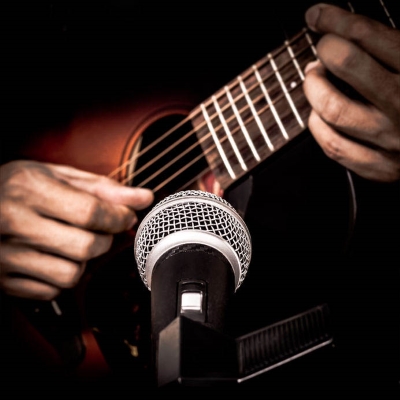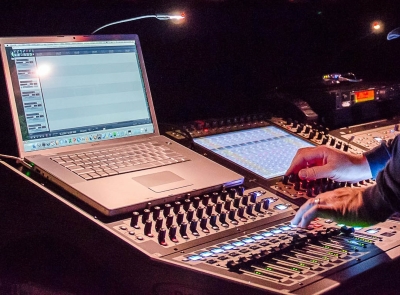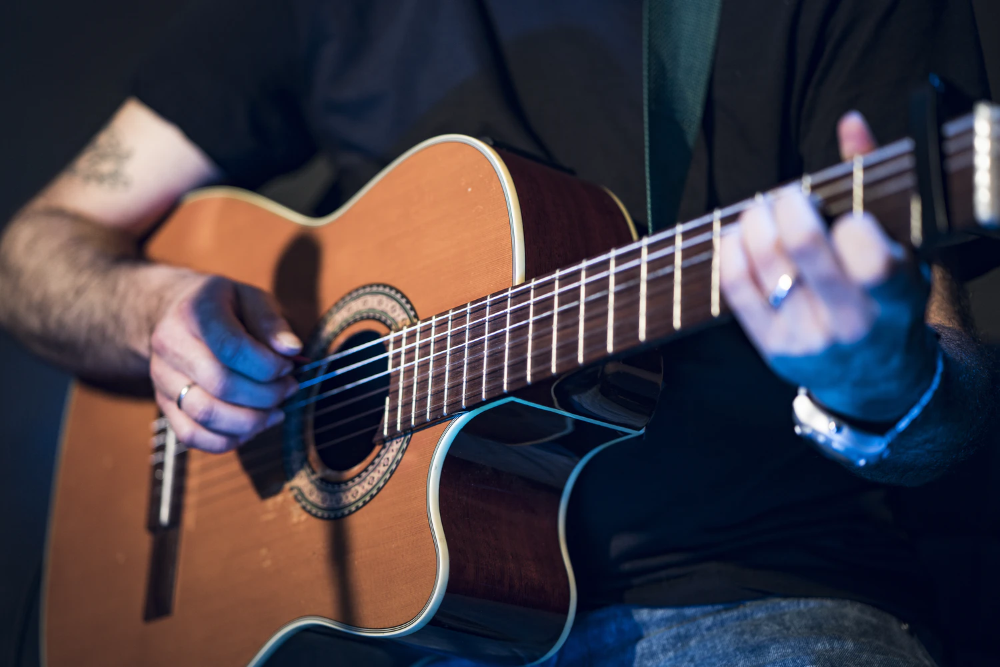“It’s going to be an easy gig – we only have three vocal microphones and an acoustic guitar.”
This is a sentence I’ve heard many times from PA providers who’ve hired me to mix. It was surely meant to provide comfort, but it had the exact opposite effect. In fact, I’ve always dreaded intimate acoustic events, and have developed several techniques for dealing with them.
Most of my experience is mixing bands. Usually, standard rock groups with acoustic drums, amplified guitars, keyboards, and vocals that have to cut through whatever sonic jungle the band is performing while still feeling like a part of the mix. These shows tend to get quite loud, and it can often be a struggle to get the main body of sound to work cohesively, leaving the delicate details behind as casualties of war. There are times I’ve felt an immense accomplishment just being able to hear the lyrics of a singer in a loud band in an even louder club.
Open-air festivals are no picnic either. Dealing with a lot of band changes with major time constraints for sound check (if there even is one) usually means rushing through channel settings, slapping on some effects, and hoping to make everything at least enjoyable by the end of the set.
My mission in both of these settings usually involves carving away slots in channels to make the whole work together. These reductions of frequency ranges can be quite brutal. If a kick drum doesn’t behave to my liking, I sometimes take away almost the entire mid-range to make room for everything else. A vocal that’s boomy in the low end will be met with a high-pass filter set quite aggressively to bring it into submission. My job is to make the entire mix work well together, not really caring if the components sound a bit wonky on their own. And having many channels to work with provides ample resources of frequencies and transients to fill in the gaps of the sonic image.

But what happens when that one lead vocal is the entire mix? How do you fill an entire venue with a sound from a single acoustic guitar that is meant to embrace and entice hundreds if not thousands of people?
My take: if you’re able to mix a small number of channels (usually for more intimate or acoustic performers) and still retain the full frequency spectrum, shape the space that matches the emotion, keep the intimacy of the performance, and allow the dynamics to shine through without getting away, you’ve reached the pinnacle of the craft. But getting there is no small task. Here’s how I approach it.
Go To The Source
Great amplified sound starts with a great source. For a nuanced vocalist, reach for a condenser microphone that can truly capture every detail, and in general, select mics and position them in such a way that they need as little intervention as possible. Also, make sure that the signal paths of the instruments on stage are free from anything that might reduce the dynamic range or signal strength.
I was recently working an acoustic show where a guest performer was a singer/acoustic guitar player, and during sound check, I struggled with the sound of his guitar. It was harsh and muddy, prone to feedback, and I couldn’t seem to shape it in any pleasing way.
The solution? Bypassing the guitar preamp/FX pedal, and then the skies literally opened. The guitar sounded full and bright, only needing minor correction in EQ. It became one of the most memorable performances of the show.
Always remember that improving the sound at the source will reduce your work at every point down the line.
Dynamics Are Key
Intimate performances tend to be quite varied in terms of dynamic range. Artists often go from whispering to screaming within a single verse. Although the idea is to tame the range so that it doesn’t cause the audience to strain through the soft parts and go deaf during the loud ones, the overall goal is preserving as much of that dynamic range as possible.
As a performer myself, I’m very aware of the fact that dynamics can be a very powerful tool in engaging the audience. If that tool is taken away because of over-compression, a performance can become flat and uninteresting. In contrast to loud bands, where I try to keep the dynamic range in a small pocket in order to bring the overall volume up in a very controlled manner, for acoustic and more intimate performances I look for ways of allowing as much of the dynamic range to shine through while still retaining some of the control.
So when mixing, I usually compress in two stages if possible – most digital consoles allow for two dynamics inserts per channel, and I use compression on both of them, at low ratios of 1:2 or 1:2.5. Also, I adjust the attack time in such a way that it’s longer on the first compressor, which retains the dynamic “feel” of the performance, and slightly shorter on the second one, which provides control over the transients in the performance. I often adjust the threshold setting on the first one during the show to better track the current dynamic feel and to bring out all of the nuances of the performer.
Another great tool for keeping a uniform sound with a lot of dynamic range are multiband compressors or dynamic EQ tools such as those on DiGiCo consoles or external plugins (e.g., F6 or C6 from Waves). Setting dynamic EQs properly can ensure that the overall sound of a channel doesn’t change with the variation in dynamics, remaining uniform throughout the performance.
EQ With A Scalpel
Keeping as much of the frequency spectrum as possible of all sources in an intimate-sounding performance is key to conveying the artist’s energy from the stage to the audience. Make sure that EQ cuts are only as narrow and as deep as they absolutely have to be. Removing large parts of a sonic image will lead to an underwhelming sound and usually won’t support the intimacy of the conveyed message.
I try to have the performer sing softly, close to the mic, and apply a high-pass filter with a shallow slope (if that option is available on the console). This helps ensure that the proximity effect will not produce any “boominess” or feedback issues, but it’s important to make sure that the low end is still present.
Next, I focus on intelligibility, adjusting the 2 to 7 kHz range to taste, and then listen for the “annoying” frequencies and apply cuts, making sure this is as precise as possible. I always try to keep in mind that there are very scarce resources for filling in the cuts.
Imagine The Space
Selecting the right ambient sound for an intimate performance is a deal breaker, and it’s almost always left at the discretion of the mix engineer. I usually prepare a few options in advance that help me decide what’s best for the given performance.

Spatial decisions are based on one fundamental principle: does the space support the intention of the performance? Is the artist going for that “playing for a few people down the pub” vibe or trying to lead the audience to an imaginary palace of magic and fairy dust? Whatever it may be, being able to enhance that energy and intention is crucial.
My effects suite for small-channel-count performances is almost always the same: a room reverb, a plate reverb, a cathedral-type reverb, and a delay unit. The room reverb is for fill-in for those moments of the show that are particularly intimate and personal. It’s added at a level where its presence can only be discerned if it were turned off, but it can’t necessarily be heard on its own.
Sometimes, equalizing this room verb also acts as an additional master EQ parameter. For example, if more low mids are needed, I can just add them to the room verb instead of the master EQ or individual channels.
The plate/hall verb is the one that can actually be heard. I almost always have the decay set between 1.3 to 2 seconds, but I also make sure that the pre-delay is set to at least 80 milliseconds. Using a longer pre-delay helps retain the intimacy of a vocal or an instrument while still developing a nice space around it. Sometimes I remove the delay from the FX chain and just play with the pre-delay on this verb to get that “one-time-repeat” delay feeling.
The cathedral-type verb is an option that I add to certain songs or moments in a performance to open up the sonic space and make it more “dreamy” or “magical.” The decay times are usually over 4 seconds, but as with the room verb, it’s never overpowering. It’s like a delicate spice in a dish, adding an extra dimension that helps the artist convey the message.
About 90 percent of the time, I EQ the verbs quite dark, with a low-pass filter set low, usually between 2 and 3 kHz. To me, intimate performances need to sound natural and a bright sounding reverb can destroy the illusion of listening to a performer up close and personal.
The delay unit comes on for certain songs, but only if I can make it blend with the rest of the space. To do that, I always run the send from the delay unit into the plate/hall reverb aux, just to make the repeats more a part of the imagined space and not having them break the illusion. Again, as with reverbs, removing the top end of the delay can help in maintaining the soundscape, making sure nothing is shifting the focus of the listeners away from the initial source.
Fader-Riding Messenger
So, if the overall intention is to create the illusion that the performer is sitting intimately in front of the audience, how much action is required on the part of the engineer throughout the show? Surely if everything is set correctly then the act should be able to perform without the engineer riding the faders and adjusting parameters throughout the show, right?
Well, at least in my experience, intimate performances actually require quite a bit of support from the engineer throughout the show. However, I hasten to add that these changes are usually minute corrections. Riding the faders should be in support of keeping the dynamic range intact and ensuring that all possible nuances are heard. My initial fader positions are set at 0 dB, which helps ensure maximum control over fader movements, and then whatever I do with levels never sounds unnatural or harsh (except when the performance demands it).
At a recent show, I was working with an acoustic band that wanted to have moments of sounds rising to levels that were almost uncomfortable for the audience, only to resolve them with very intimate and quiet passages. Although making sure that it was not unbearable, I supported those “noisy” moments by pushing the faders up while also enhancing the dynamic range and helping the act convey the message, which is the point of all of these techniques.
But the underlying principle is the most important one: do whatever is needed for the song and performance to convey the intended meaning from the stage to the ears (and hearts) of the audience.
Although this applies to all shows, the ones with small channel counts usually need that support the most. Because there’s far less material to work with in terms of channels, there’s no place to hide – every decision you make will be displayed for all to hear.















